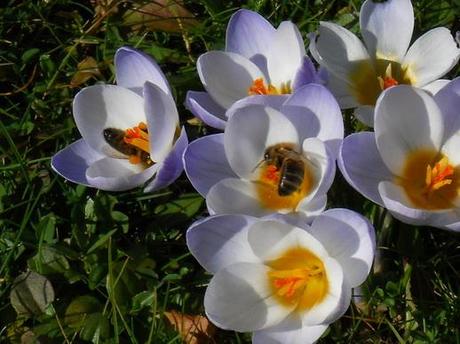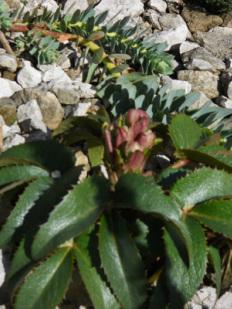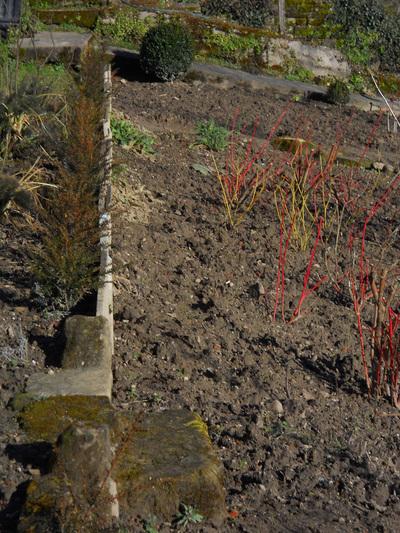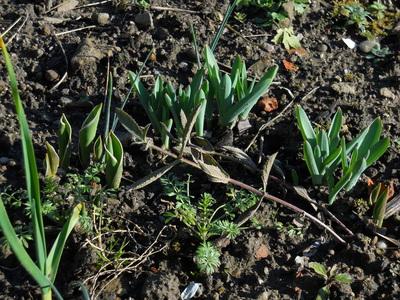 Whenever we have some sunshine, the bees are loving my little Dutch crocuses, planted in autumn 2012. Strangely, of the 25 Crocus tommasinianus corms that I planted last autumn, only 6 have made an appearance above ground - and much later than the other crocuses. Hopefully they are building strength for a flourish in 2015, but I doubt it. Perhaps I planted them too deeply or they rotted with all our winter rain?
Whenever we have some sunshine, the bees are loving my little Dutch crocuses, planted in autumn 2012. Strangely, of the 25 Crocus tommasinianus corms that I planted last autumn, only 6 have made an appearance above ground - and much later than the other crocuses. Hopefully they are building strength for a flourish in 2015, but I doubt it. Perhaps I planted them too deeply or they rotted with all our winter rain?I heard my first woodpecker of the year in the forest opposite the garden this afternoon. A little later came the more disturbing sounds of hunters thrashing about in the undergrowth. I find them unnerving (even when they don't lose their hounds and leave them to rush about for hours on their own, baying in a distressing kind of way). A week ago there came terrible screams when they were 'doing their weekend thing'. A short while later a small baby wild boar rushed into the bottom of our garden and charged about in desperation before finally making its way along the river bank. I suspect that the screams were the sound of its mother meeting her end in the woods. Hopefully the baby survived, albeit to live a rather solitary existence.
 Helleborus x sternii (ex 'Boughton Beauty', courtesy of the Hardy Plant Society seed list in 2012) is starting to come into flower on the Mirror Garden scree bed. I noticed that in a seed pot of Helleborus argutifolius, which was sown and germinated poorly last year, there is a new flush of little seedlings coming up next to the two 2013 plants. The seed pot was given cold treatment in the fridge, but obviously needed more time to break the dormancy of all the seeds. Since they were in a cold room (min 2 degrees), rather than out in the frame this winter, there can't have been much of a 'double-chill' effect.
Helleborus x sternii (ex 'Boughton Beauty', courtesy of the Hardy Plant Society seed list in 2012) is starting to come into flower on the Mirror Garden scree bed. I noticed that in a seed pot of Helleborus argutifolius, which was sown and germinated poorly last year, there is a new flush of little seedlings coming up next to the two 2013 plants. The seed pot was given cold treatment in the fridge, but obviously needed more time to break the dormancy of all the seeds. Since they were in a cold room (min 2 degrees), rather than out in the frame this winter, there can't have been much of a 'double-chill' effect. Also looking jolly, a seedling Fraxinus angustifolia subsp. oxycarpa. I had this seed in 2012, the last year that the RHS distributed ash seed, due to the dreaded ash dieback (Chalara fraxinea). Apparently the disease is transmitted by seed, and I must admit I am a little dubious about my seedling, but since it is such a pretty tree with coral-red young growth, I'm taking the risk and growing it on.

 My little yew hedge (left, above), which will form a boundary between the Rose Walk and the Long Border, is showing quite a lot of reddish foliage. I don't think it has enjoyed this wet winter on my heavy clay at all. Fingers crossed that when everything warms up a little it will battle its way through to health. I'd be sorry if too many plants died, because that would mean I couldn't reliably use low yew hedges as a substitute for box. Beyond the hedge, to the right, are the Cornus alba 'Sibirica' and Cornus alba 'Flaviramea' plantings. Hopefully in the end I'll be able to add snowdrops, Ajuga reptans, hardy geraniums and some Eranthis hyemalis to complete the wilder side of the top winter garden, with the knot garden on the other side of the path.
My little yew hedge (left, above), which will form a boundary between the Rose Walk and the Long Border, is showing quite a lot of reddish foliage. I don't think it has enjoyed this wet winter on my heavy clay at all. Fingers crossed that when everything warms up a little it will battle its way through to health. I'd be sorry if too many plants died, because that would mean I couldn't reliably use low yew hedges as a substitute for box. Beyond the hedge, to the right, are the Cornus alba 'Sibirica' and Cornus alba 'Flaviramea' plantings. Hopefully in the end I'll be able to add snowdrops, Ajuga reptans, hardy geraniums and some Eranthis hyemalis to complete the wilder side of the top winter garden, with the knot garden on the other side of the path. The tulips and alliums (right, above) are comforting me with lots of healthy shoots. Best of all, I seem finally to have made Eryngium giganteum 'Mrs. Willmott's Ghost' at home! I've been trying to germinate seed for a number of years now. Last year was the breakthrough, and four plants in the Rose Walk have come through the winter. If you also garden on heavy clay, in a cold, continental climate, you might be interested in the list of plants that have survived here. I'm planning to add it in the next few weeks and would welcome your thoughts.
